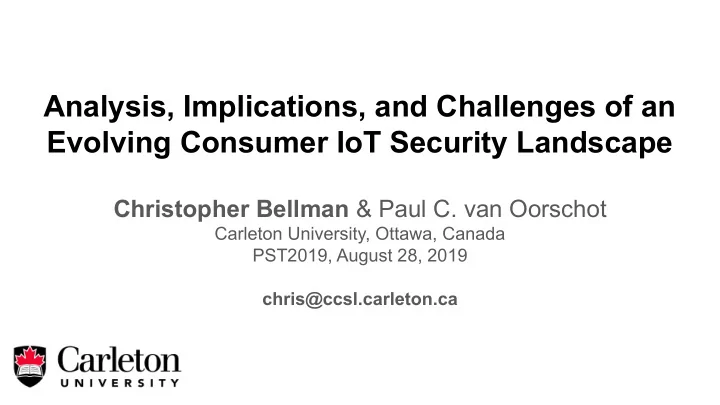

Analysis, Implications, and Challenges of an Evolving Consumer IoT Security Landscape Christopher Bellman & Paul C. van Oorschot Carleton University, Ottawa, Canada PST2019, August 28, 2019 chris@ccsl.carleton.ca
The “Internet of Things” “ Internet of Things ” (IoT) ● Commonly, “ adding network connectivity to everyday objects ” ● E.g., toaster, TV, thermostat Being added everywhere: ● Critical infrastructure : Power, water, telecom ● Smart cities : Road sensors, traffic lights, security cameras ● Industrial : Building lighting, automated factories, remote monitoring Our focus: Consumer-grade devices Low-power wireless Wi-Fi ● Common to have many devices per house Wired Introduction/Background > Characteristics/Implications > Conclusions 2/10
Distinguishing Characteristics of IoT Internet of Computers (IoC) ● Desktop/laptop computers, smart phones, servers, etc. While similar in many ways, the IoT differs from the IoC We highlight five characteristics of IoT ● These characteristics distinguish IoT from IoC Each characteristic has implications for IoT security ● These implications present unique issues that will need to be addressed Introduction/Background > Characteristics/Implications > Conclusions 3/10
1. Low-Cost Everyday devices but with included network connectivity ● “ Low-cost” referring to IoT sub-component ● E.g., adding communications to a toaster, TV, light bulb, door lock Manufacturers may favour low-cost and market presence over security ● Investing in security generally costs more money ● Security often takes back-seat while establishing presence Implications for security: ● Constrained resources ● Small/no OS ● Need for more efficient protocols ● Need for lightweight crypto ● Over-provisioned functionality ( cost-friendly component reuse) ● Manufacturer security inexperience (for IoT sub-component) Introduction/Background > Characteristics/Implications > Conclusions 4/10
2. Non-Standard Interfaces Typical device interfaces/interaction design : ● IoC: keyboard + mouse, touchscreen ← “standard” interfaces ● IoT: phone/hub, voice, cloud-based web ← not standard interfaces Device diversity is high ● Many different interfaces, interaction styles ● Possibly highly-constrained, some interfaces may not work Implications for security: ● New attack surfaces ● Greater physical access to devices ● Complicated device management, config., updates ; exacerbated by scale Introduction/Background > Characteristics/Implications > Conclusions 5/10
3. Cyberphysical Interaction Terms “Cyberphysical system” and “IoT device” have merged definitions over time ● For our purposes, simply “a device that interacts with and affects its environment ” Two basic types of cyberphysical device: ● Sensor (physical→digital) ● Actuator (digital→physical) Implications for security: ● Successful network attack may affect physical world ● Implied trust in manufacturer Introduction/Background > Characteristics/Implications > Conclusions 6/10
4. Expectation of Long-Lived Devices Users expect their devices to last for a long time Depending on the device, interaction may be kept at a minimum ● A “ set-and-forget ” device to function for a long time ● A smart motion sensor: set up, forgotten about until it stops working Implications for security: ● Lack of software updates may leave vulnerabilities unpatched ● Forgotten devices remain attractive targets ● Device outliving manufacturer impacts software updates ● Cryptographic algorithms and protocols must be future-proofed Introduction/Background > Characteristics/Implications > Conclusions 7/10
5. “Many-User” Devices with Unclear Authority In IoC , devices are “ multi-user ” or “ single-user ” based on architecture and usage ● IoT devices often belong to an environment rather than a user ● IoT : may be used by many users , without identification → a “ many-user ” device ● E.g., Amazon Echo voice commands Implications for security: ● Home guests may be denied functionality of critical services ● Rogue guests may retain remote access ● Difficult to differentiate authorized and unauthorized users Introduction/Background > Characteristics/Implications > Conclusions 8/10
Common Themes Two common themes visible in IoT : 1. Current/expected scale ○ The scale of IoT exacerbates problems associated with characteristics ○ Methods for handling scale will become increasingly important 2. Lack of standard toolkits/software ○ Generally acknowledged that IoT is vulnerable - what tools are available for developers? ○ Given resource constraints , we need: ■ Lightweight crypto toolkits ■ Common algorithms updated to meet performance challenges ■ Securely-designed OSs for Class 1+ devices ( common codebase ) Introduction/Background > Characteristics/Implications > Conclusions 9/10
Analysis, Implications, and Challenges of an Evolving Consumer IoT Security Landscape Christopher Bellman & Paul C. van Oorschot Carleton University, Ottawa, Canada PST2019, August 28, 2019 chris@ccsl.carleton.ca
Constrained IoT Devices RFC 7228 Volatile Non-volatile OS & Communications Class memory memory (KiB) (KiB) Class 0 <<10 <<100 OS: Function-specific hardware, few IoT OSs Comms: Basic health indicators, keep-alive messages; requires intermediate node for further communication Class 1 ~10 ~100 OS: IoT-specific OSs Comms: Lightweight wireless (e.g., BLE)/wired, UDP-based protocols Class 2 ~50 ~250 OS: IoT-specific OS Comms: Lightweight wireless/wired, UDP-based protocols, commonly-used upper-layer protocols Class 2+ >50 >250 OS: IoT-specific, full OS (e.g., Linux) Comms: Commonly-used communication protocols Introduction/Background > Characteristics/Implications > Conclusions 11/10
Recommend
More recommend